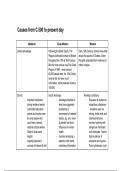Causes from C.500 to present day
Medieval Early-Modern Modern
Limited knowledge Following the Black Death, The Early 19th-Century doctors knew little
Plague continued to return to Britain about the causes of Cholera. Some
throughout the 15th & 16th Century. thoughts originated from miasmas or
But the most serious was The Great rotten corpses.
Plague of 1665 - when around
65,000 people died. As 17th Centiry
records did not have much
information, some believed closer to
100,000.
Church: God & Astrology: Working Conditions:
- important insisitution - Astrological beliefs of - Exposure of workers to
during medieval period time time suggested hazardous substances
(controlled education, positioning & - industries such as
priests and monks were movements of celestial mining, textile mills and
the only people who bodies, eg. sun, moon chemical factories
could read, opened & planets had drect involved working with
medical schools where influence on human dangerous machinery
Galen’s ideas were health and chemicals - lead to
taught) - Involved analyzing a high incidence of
- majority believed in patient’s birth chard - accidents and injuries.
concept of Heaven & hell containing information Toxic substances, such
, and need to repent for about positions of as coal dust, asbestos
sins celesial bodies of their and lead caused
- Taught that if you live a birth respiratory problems,
sinful life, God will send - When Bubonic Plague cancer and other
disease as a punishment swept across Europe in serious illnesses.
to cleanse the soul 14th Centiry, - Long working hours,
Supernatural: astrological lack of breaks - meant
- Feared ghosts & spirits explanations used for workers had little time
were to be blamed cause of disease to rest or recover from
- Would curse humans on .Living Conditions: their injuries or
Earth - Many were to share the illnesses - created an
- Disease came from same small and dirty environment in which
supernatural or Divine rooms and same beds - workewrs were more
Forces meaning disease would suspectible to
Famine: spread quickly infections and other
- farming was crucial for - Dirty streets - waste diseases
peasentry was not removed from - Workers were
- many were dependent on streets - people lived in malnurished and had
good harvest to survive filthy conditions, lead to poor working conditions
- basic techniques & tools disease spreading - weakened immune
were used - lead to years - Death - coffin being system
of hardship & fammine - carried among strets - Poverty:
starvation at an extreme, showed people were - Young children would
weakening the immune around dying or dead work by cleaning up
system, leaving the body people - easier for them chimneys and did
susceptible to infectious to catch disease dangerous jobs - so
diseases at the time Miasma: ubhealthy, made them
, Living Conditions: - Caused by inhalation of more likeley to die from
- Small towns - Domesday poisonous fumes or diseases
Book of 1087 had onlky 6 vapors - believed to - Lack of malnutrition -
towns recorded in it - arisde from decaying people unabler to afford
were important places organic matter, sewage, healthy and balanced
where trade can take and other sources of diet - lead to
place pollution deficiencies in essential
- Unhygienic, crowded, Hygiene: vitamins and minerals
overwhelming number of - Little knowledge of - Lack of access to
rats, waste thrown on importance of healthcare - could not
streets, animal manure handwashing and basic afford treatment or
littered road hygiene practices - medicine - meant
- Many peasants lived in such as bathing and illnesses and diseases
cruck houses - simple, teeth brushing not often went untreated or
one-room shelters, made commonly practiced - treated too late, leaded
from wattle & daub - a allowed for bacteria & to sevewre health
mixture of straw, reeds, viruses to accumulate problems
mud & manure on skin, mouth and Spanish Flu 20th Century -
- no running water or other parts of the body - claimed millions of lives
toilets - due to no which would easily worldwide, causes were
knowledge of causes, spread to others complex, but several factors
water typically used from through physical contributed to spread
nearest local river - same contact or sharing of - WW1 conditions -
river used to dump contaminated objects movement of troops
waste, wash clothes, - Lack of access to clean acrtross borders &
used as toilets water and proper croweded conditions of
military camps and




